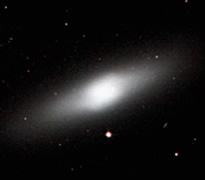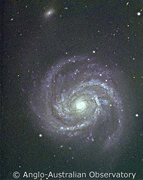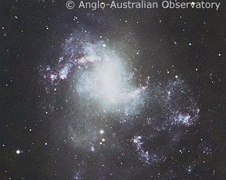Galaxy Types

|

The early-type (S0) galaxy NGC4526.
Credit: DSS |

The late-type (spiral) galaxy M100.
Credit: AAO |

The late-type (irregular) galaxy NGC1313.
Credit: AAO |
For ease of reference, the Hubble classification scheme is often used to subdivide galaxies into two morphological ‘types’:
- Early-type galaxies: elliptical and S0 galaxies.
- Late-type galaxies: spiral and irregular galaxies.
Although we now know that the Hubble classification does not form an evolutionary sequence, these names are derived from this initial assumption.
A comprehensive survey of nearby galaxies reveals the following percentages for the different morphologies:
- 10% elliptical
- 20% S0 (lenticular)
- 60% spiral
- 10% irregular or peculiar
Extrapolating to the Universe as a whole, it is estimated that 70% of all galaxies are late-type galaxies and only 30% are early-type. However, this is in contrast to what is found in galaxy clusters where early-type galaxies dominate – an example of the observed morphology density relation where the dominant galaxy type varies with environment.
Study Astronomy Online at Swinburne University
All material is © Swinburne University of Technology except where indicated.

